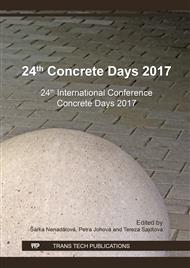p.197
p.203
p.209
p.214
p.220
p.226
p.232
p.238
p.244
Detailed Determination of Mechanical Fracture Parameters of Concrete after Fire Experiments
Abstract:
The aim of this paper is to describe the procedure of determining the mechanical fracture parameters of selected concrete specimens taken from panels after the fire experiments. The records (in form load vs displacement diagrams) of three-point bending fracture tests of these specimens with initial stress concentrators was first advanced corrected and subsequently evaluated using the Effective Crack Model and the work-of-fracture method. The increasing temperatures during the fire experiments ranging between 550 to 1000 °C led to a decrease of modulus of elasticity and fracture toughness values and to the increase of fracture energy value. The 2D laser profile scanner was used to estimate the degree of complexity of fracture surfaces; its statistical dependence on the mechanical fracture parameters proved to be moderate – the absolute value of the correlation coefficient was about 0.5°[–].
Info:
Periodical:
Pages:
220-225
Citation:
Online since:
February 2018
Authors:
Keywords:
Price:
Сopyright:
© 2018 Trans Tech Publications Ltd. All Rights Reserved
Share:
Citation:


